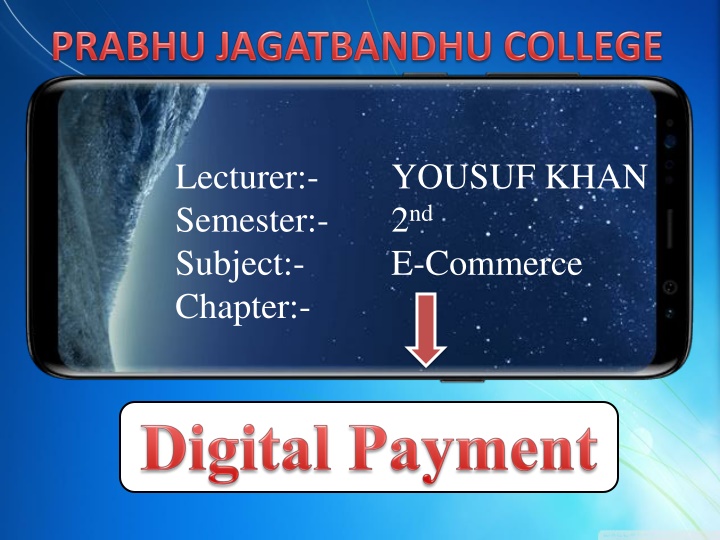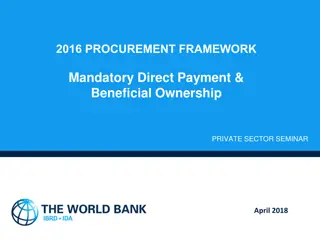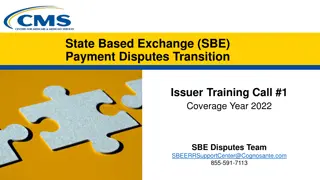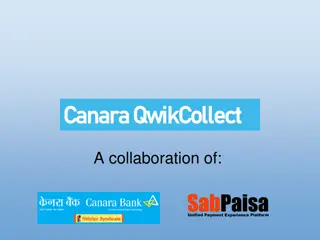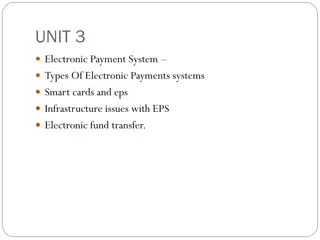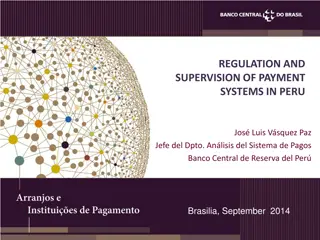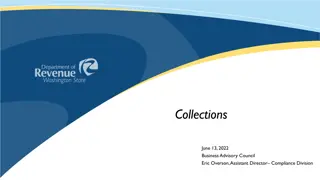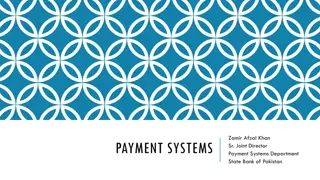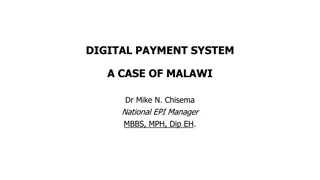Digital Payment Methods and Security Issues Explained
Digital payment methods like credit and debit cards, e-wallets, and smart cards are becoming increasingly popular in a cashless economy. This article discusses the types of digital payment methods available, such as credit and debit cards, and addresses security issues related to using these forms of payment, including tips for safeguarding your financial information.
Download Presentation

Please find below an Image/Link to download the presentation.
The content on the website is provided AS IS for your information and personal use only. It may not be sold, licensed, or shared on other websites without obtaining consent from the author.If you encounter any issues during the download, it is possible that the publisher has removed the file from their server.
You are allowed to download the files provided on this website for personal or commercial use, subject to the condition that they are used lawfully. All files are the property of their respective owners.
The content on the website is provided AS IS for your information and personal use only. It may not be sold, licensed, or shared on other websites without obtaining consent from the author.
E N D
Presentation Transcript
Lecturer:- Semester:- Subject:- Chapter:- YOUSUF KHAN 2nd E-Commerce
What is a Digital Payment ? services are purchased through the use of various electronic mediums. There is no use of cash or cheques in this type of payment method. To put it in simple words, a digital payment occurs when goods or What is a Cashless Economy ? In a cashless economy, all transactions are carried out using different types of payment methods and this does not involve the physical use of money for the purchase of various goods and services.
Payment Card [Credit and Debit Card] Store value card [Smart card] Methods Of E-Payment Electronic or Digital Cash Store value card [Smart card] Electronic or Digital Wallet
1. Payment Card [Credit and Debit Card] a) Credit Card:- Credit card are very commonly used as a tool for electronic payment. It is a thin plastic card that can be used to buy items, meet food or restaurant bills, booking of airline tickets etc. Any credit card allows a user to pay later for the items one has bought or the services availed, hence the name credit card is given. This process of payment is known as charging. Charging means that one user had paid for the items his or her credit card by promising to pay when the user had signed the credit card receipt. Credit card are normally issued from a bank or any authorized authority.
1. Payment Card [Credit and Debit Card] Security issues while using Credit card- Taking Care of one s credit card receipts. The credit card should not be out of one s sight. Losing a credit card. Keeping two different credit card in different place while travelling. Security issues while shopping online. Taking care of old / previously used credit cards.
1. Payment Card [Credit and Debit Card] b) Debit Card:- A debit card (also known as a bank card, plastic card or check card) is a plastic payment card, that can be used instead of cash when making purchases. It is similar to a Credit card, but unlike a credit card, the money comes directly from the user's bank account, when performing a transaction. Payments using a debit card are immediately transferred from the cardholder's designated bank account, only if sufficient balance is available, If not the transaction will be failed. Debit cards usually also allow for instant withdrawal of cash, acting as an ATM card for withdrawing cash.
1. Payment Card [Credit and Debit Card] Security issues while using an ATM cum debit card- PIN Number CVV Number Change default PIN Card and PINs are kept Separate. Call the Helpline Immediately needed. Apply for Mobile Alerts Follow Rules
2. Electronic or Digital Cash Digital cash refers to a format of electronic data that is similar in functions like that of our traditional paper cash. Digital cash can be stored, Transferred , paid and verified electronically through the use of different digital devices such as Computers, Mobile phones etc.
2. Electronic or Digital Cash Points to remember- Like traditional paper cash, the model of digital cash also involves three parties- Customer, Trader and Bank. The digital cash can not be manipulated and refused by a user illegally. Digital cash ensures privacy or untraceability. The digital cash can be transferred between different customer without involvement of the bank before finally deposited into the customer s bank A/c Trader can verify the validity of e cash without involvement of the bank. Without the bank s interference, a user can subdivide an amount of e-cash in a given amount into smaller subdivisions of e-cash. the security of e-cash does not depend on any physical or geographical locations or special devices.
3. Electronic or Digital wallet An electronic wallet or E-wallet is defined as an encrypted medium for storage or holding credit card and other confidential financial information that can be used to complete electronic transactions without re-entering the stored data at the time of transaction itself. Access to E-wallet requires password or keys .
3. Electronic or Digital wallet Functions of Digital wallet Managing of one s payment and accounts. Getting of offers from traders one knows and can depend upon. Storage of digital receipts and warranty information. Getting of alerts about one s account and one s spending. Security issues associated with Digital wallets Providing protection through password as well as providing physical protection to the devices which are to be used to access the payment options such as PC, mobile phones, laptops, tablets etc. Only the owner can access sensitive information such as including User name, password, PINs and answers to security options.
3. Electronic or Digital wallet Advantages of Using Digital Wallet Time Saving- Many times when you go for online shopping or for mobile recharge, you even wouldn t have time to enter your Credit card details. Security Track the Expenditure Attractive Discounts- If you re using digital wallet of any online wallet provider, you may find some discounts Disadvantages of Using Digital Wallet International Restriction- Every country has different services and so the different digital wallets. Limited Merchants Dependent on the Devices Danger of Losing your Money
4. Stored value Card (Smart card) A stored-value card is a payments card with a monetary value stored on the card itself, not in an external account maintained by a financial institution. Stored-value cards differ from debit cards, where money is on deposit with the issuer,and credit cards which are subject to credit limits set by the issuer. Another difference between stored-value cards and debit and credit cards is that debit and credit cards are usually issued in the name of individual account holders, while stored-value cards may be anonymous, as in the case of gift cards. Stored-value cards are prepaid money cards and may be disposed when the value is used, or the card value may be topped up, as in the case of telephone calling cards or when used as a fare cards. Like Amazon gift card, Metro ticket cards, Big bazar cards. These cards are two type- 1. Closed loop Stored value Card . 2. Open Loop Stored value Card .
5. E - Money Electronic money is money which exists in banking computer systems and is available for transactions through electronic systems. Its value is backed by fiat currency and it can be exchanged into physical form however its uses are often more convenient electronically. E Money in India At the end of May 2017, Paytm India s largest mobile money company launched Paytm Payments Bank, having received the last clearance from the Reserve Bank of India (RBI). We wish to acquire 500 million new customers and launch a slew of financial services products such as deposits, wealth management, insurance, financial lending and many more, E- money is therefore not a result of demonetization, but it has taken off following the controversial move by the Indian government to remove Rs500 and Rs1,000 notes from circulation. Prevention of corruption and the spread of black money, choking terror funding, and the creation of a cashless society were the main objectives of the demonetization measure.
